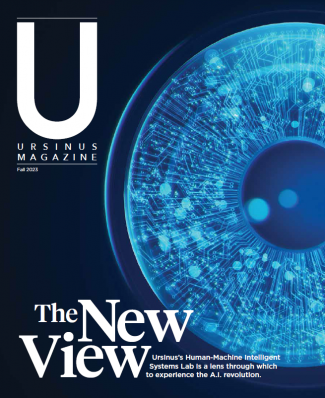
Getting to Know Leah Joseph
This Ursinus geologist’s research goes to great depths (literally) to study climate conditions of the recent—and not so recent—past.
This fall, your global climate change course will take you and your students to the edge of Lake Ontario and to the Finger Lakes. What do you hope to find there?
In this class, we spend a bit of time learning about different types of records of climate conditions. This includes learning about ocean and lake sediment (the sediment accumulates through time and can record some of the conditions under which it was deposited). So, we’re taking a research boat out on Seneca Lake to collect sediment sequences in cores from the bottom of the lake. I love for my students to have the opportunity to see the process of obtaining samples from the (near) start. I’ve found that students really appreciate the opportunity to participate in the fairly unusual experience of going out on a research vessel to collect sediment cores, are much more invested in analyzing the samples that we have collected ourselves, and gain a better sense of both the fun and the challenges inherent in “doing science” and of working on real samples and data.
Being on a research vessel sounds quite thrilling. What—or where— would be your dream research expedition and why?
I do really enjoy being out at sea on research expeditions. There are a number of ways to consider a dream research expedition: location, research, results, good community, safe travels, etc. Although it’s not my current field of oceanographic research, one of the very first papers I wrote in my undergraduate oceanography class made me want to one day go down into the deep sea in a submersible (such as Alvin) and observe the really interesting varieties of life, as well as the geologic features found at deep sea hydrothermal vents at mid-ocean ridges. Maybe one day I’ll be able to get to view the ocean from deep below.
What can we learn from previous climate conditions that can inform how we think about the impact we have on climate in the future?
Studying previous climate conditions helps us understand how the Earth’s climate systems work and the extent of climatic variability that the Earth has experienced in the past. This is key information in predicting changes that will happen from the combination of natural and human-caused alterations to the climate system in our modern world and into the future. These predictions are valuable in deciding what to do, and how quickly to act, in regard to reducing our impact on climate and helping particularly vulnerable communities adapt to the negative impacts of climate change.
Anyone who is familiar with Pfahler Hall has probably seen the mineral collection there. Do you have a favorite?
That’s hard to say! There were so many spectacular specimens donated to Ursinus that form this collection. What I found when we were working through curating and labeling them was that I would be wowed by one sample that I was looking at, then pick up the next and be amazed by something different about the next one. Sometimes a specimen is visually appealing (color, sparkle, crystal shape, size, etc.); sometimes there’s something a little different about them that one might not usually see. Sometimes one has to look closely, but the minerals exhibit both the regularity/ predictability, as well as the variation, often present in nature and I find that really appealing.
So, do you have a favorite geologic timeframe?
I think probably starting with the Paleozoic all the way through recent times would be my favored (very broad) timeframe. To get more specific than that would be hard. As soon as I start to remember all the different things that developed, grew, or changed during each time period, I would switch my answer accordingly! I do probably have a particular fondness for fossils from the earlier periods of the Paleozoic though; a lot of my initial exposure to geology and the fossils from this interval came during my time as an undergraduate in upstate New York.


